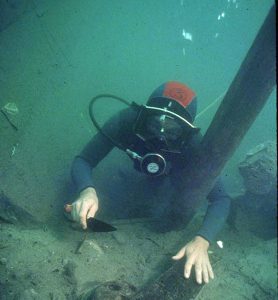 Virginia Department of Historic Resources
Virginia Department of Historic Resources Virginia Department of Historic Resources
Virginia Department of Historic Resources
Virginia has a richly diverse maritime heritage, beginning with the first inhabitants of present-day Virginia, some of whom lived near our plentiful bays, rivers, and streams. These first people found abundant food along the coasts, including fish and oysters, and they developed tools and techniques for harvesting them. They built boats from hollowed out logs and used them to explore, fish, and hunt.
The first European colonists arrived on Virginia’s shores in their large sailing ships and they, too, discovered the bounty in coastal and riverine waters. They built small boats for exploring and fishing, and most of the earliest settlement was along the James River. Even today, Virginia’s maritime heritage is evident in many places, including our coastal settlement patterns, the huge shipyard in Newport News, and the largest naval base in the world, Naval Station Norfolk.
Lying on Virginia’s submerged lands are countless thousands of archaeological sites representing every period of occupation from the first Virginia Indians to the present day. A portion of the first fort built at Jamestown eroded into the James River, and the York River holds more than a dozen ships sunk during the Battle of Yorktown in 1781, the last major battle of the American Revolution. In other areas lie the remains of Union and Confederate ships from the Civil War. Other types of underwater sites include prehistoric sites that were inundated during a long period of sea level rise; the remains of piers, wharves, ferry landings, bridges, and other waterfront structures; and countless prehistoric and historic sites that formerly existed on land, but have become submerged due to storms, erosion, and sea level rise.
The Department of Historic Resources works with federal, state, and private partners in an effort to locate, study, and protect its underwater historic property.
Removing objects from underwater historic sites requires a permit from the Virginia Marine Resources Commission.
For more information on the Underwater Archaeology Program, please contact Underwater Archaeologist Brendan Burke at (804) 482-8088.
Updated October 6, 2021